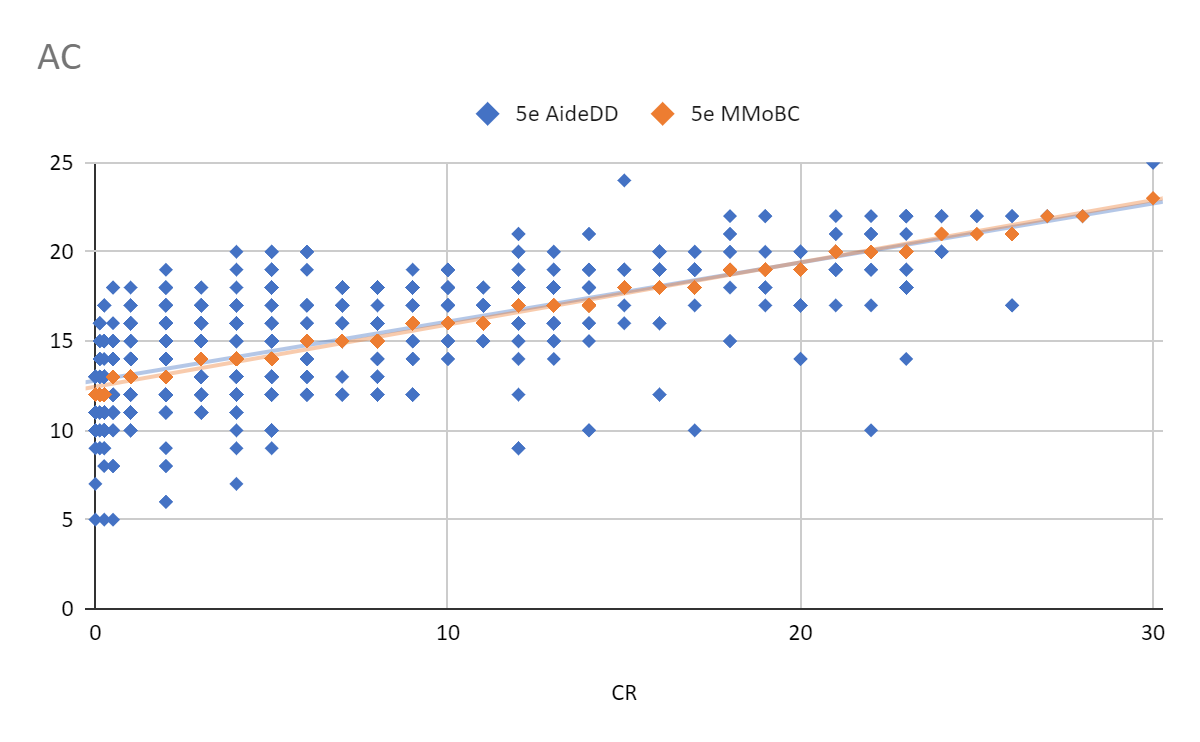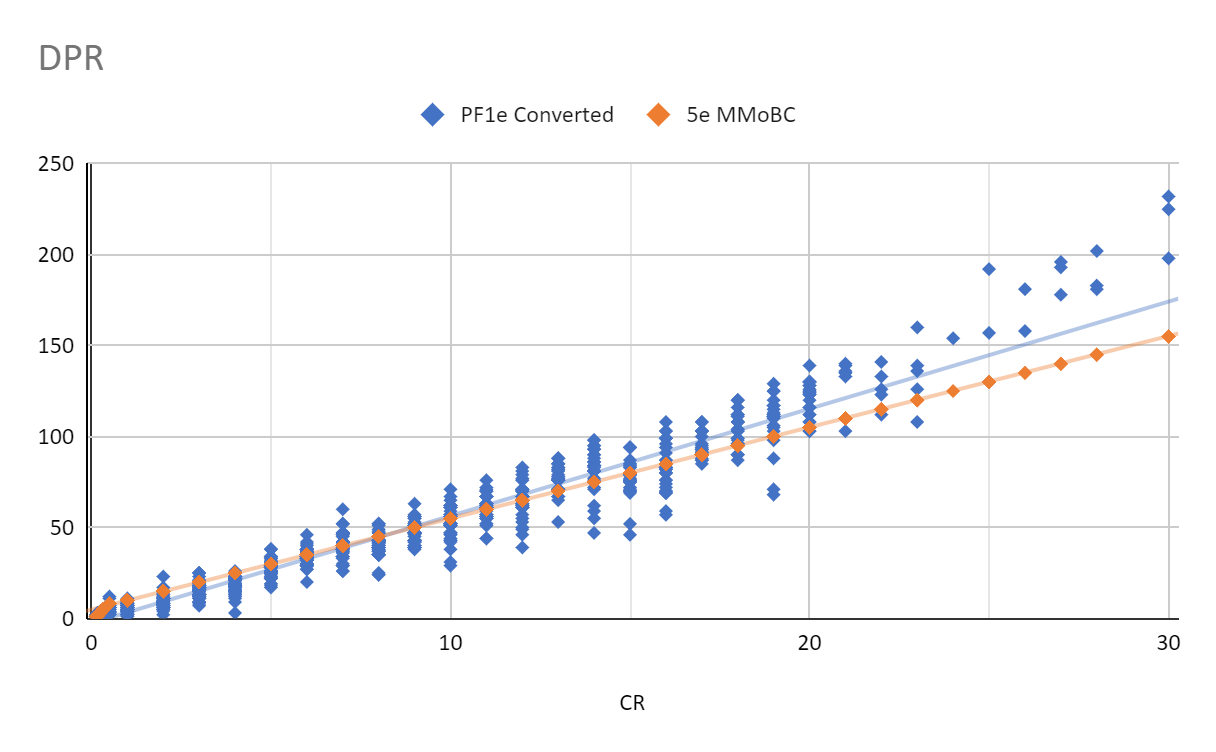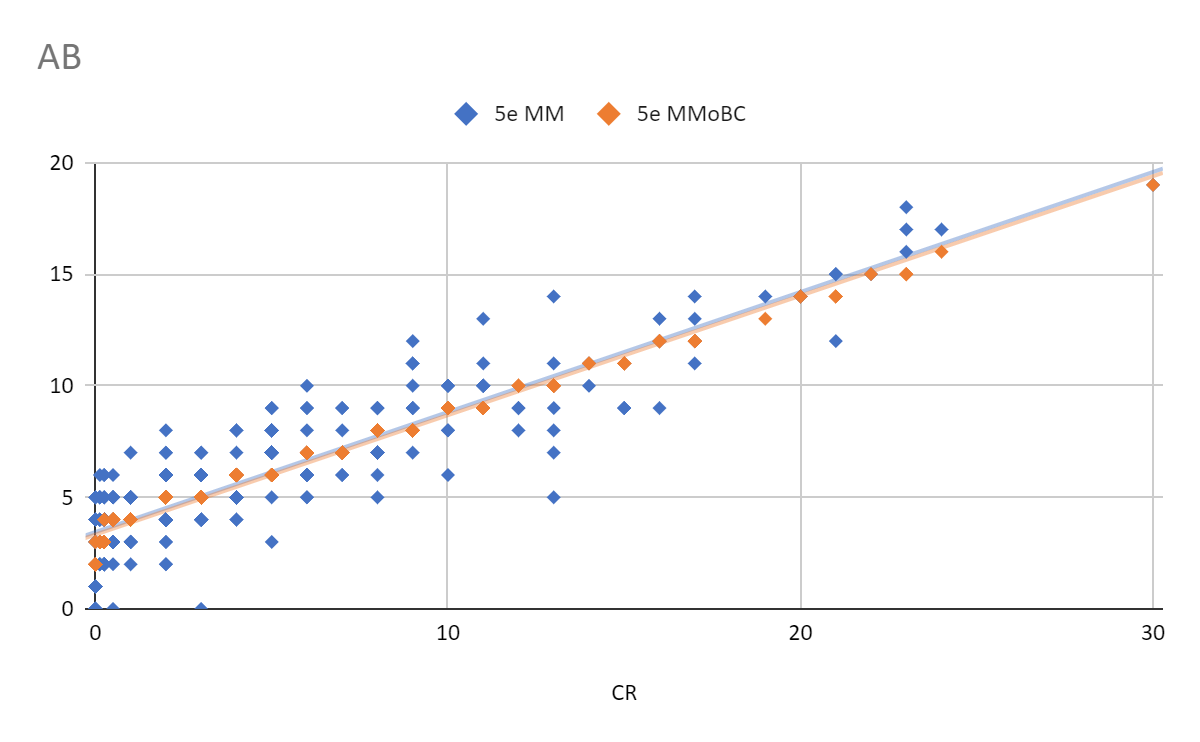Carcharoth
Explorer
Due to the recent OGL upheaval and associated uncertainty of 5e’s future, I decided to formalize and share an updated version of some previous work. Perhaps a few of you who have enjoyed the many d20 adventures, settings, etc. published over nearly two decades will find the following useful.
It is important to note that converted monsters retain their original CR. For example, a PF1e ogre converted to 5e will remain CR 3 rather than change to CR 2 as listed in the 5e MM.
Note: Round down fractional results
In 2020, I finally stumbled upon the fantastic, must read 5e Monster Manual on a Business Card (MMoBC) by Blog of Holding. The article is a literal game changer in that it not only provides an easy-to-use cheat sheet for monster stat creation but also uses data directly from the 5e MM itself to correct the 5e table’s deficiencies.
As a result, I added the MMoBC’s equations to the previous spreadsheet of 1413 entries from PF 1e Bestiaries 1 through 4 (via the Pathfinder Community Monster DB) and performed a new analysis, the specifics of which I present below.
Important: As opposed to the prior article that focused on how well the results of 4 different methods matched expected CRs, this article focuses on how closely converted stats match those from the MMoBC and, therefore, official 5e monsters.
Results: 99.36% of entries (1404 out of 1413) fall within +/-3 of expected values.
Excellent considering that 90.26% of 1027 monsters from official 5e resources match the same criteria.
Distribution of PF1e Converted AC to MMoBC equations

Distribution of Official 5e ACs and MMoBC equations

Results: 94.48% of entries (1335 of 1413) fall between +/- 50% of the expected value.
Very nice considering that 90.46% of 1027 monsters from official 5e resources match the same criteria.
Note: HP are higher in the upper CR ranges for both converted and official monsters.
Distribution of PF1e Converted HP to MMoBC equations

Distribution: AideDD Data to MMoBC

Results: 94.27% of entries (1332 of 1413) fall between +/- 50% of the expected value.
Excellent considering that 82.53% of the 395 monsters in the 5e MM that do attack damage match the same criteria.
Note: Similar to HP, DPR is higher in the upper CR ranges for both converted and official monsters.
Distribution of PF1e Converted DPR to MMoBC equations

Distribution of Official 5e DPR and MMoBC equations

For more information on dividing the DPR total (budget) into attacks, see 5e Monster Manual on a Business Card
Results: The precision of this equation becomes clear after calculating both Proficiency Bonus and Attack Bonus below.
The PB is an integral part of 5e design and is used to calculate the following primary stats: Attack Bonuses, Saving Throws, Difficulty Checks, and number of Skills.
Results: 96.74% of entries (1367 out of 1413) fall within +/- 2 of expected values while 99.08% (1400) are within +/- 3.
Excellent considering that, of the 407 monsters in the 5e MM that rely on an Attack Bonus, 92.38% fall within +/- 2 while 96.31% fall within +/- 3.
At this point, it becomes clear that the Ability Modifier is practically dead on and, as a result, the remainder of stats will also fall similarly in line.
Distribution of PF1e Converted DPR to MMoBC equations

Distribution of Official 5e ABs and MMoBC equations

Although the converted PF1e AB dips a little from CR 23 to 30, the lower values add a nice counterbalance to the higher DPR of the same range.
Note: Monsters that rely on their Spell DC rather than an AB account for some values beyond the range of tolerance in both systems.
Since the remaining stats rely just as much on Ability Modifiers as the Attack Bonus does, they too will match expected values with similar precision.
Unlike the previous article that only compressed values over 20, this method compresses the entire range of ACs which provides not only greater precision but also greater variety at the top (less of a direct relationship between CR and AC).
As a result, the recomputed PF1e AC range of 20 to 50 becomes 20 to 30, thereby matching 5e.
Although the official Wizards conversion doc suggests capping AC at 22, the Pathfinder multiverse contains a handful of monsters that are intended to rival if not dominate a Tarrasque. Consequently, a total of 15 re-computed ACs range from 23 to 25.
Since monsters with Ability Scores 19 and under (AM +4) present no problem, only those scores 20 and over need to be compressed.
As a result, the recomputed PF1e AM range of +5 to +20 becomes +5 to +10, thereby matching 5e.
Note: There is one exception. The Great Cthulhu is the only creature with a stat high enough (STR 56) to result in a +11 Ability Modifier. However, since the Great Old One’s final Attack Bonus is 20 (PB + AM), everything still falls within +/- 2 of the MMoBC’s expected value of 19, so all is good.
Example:
Example:
Example:
Data from AideDD’s Monsters 5e Page was used to compare and contrast the distribution of AC and HP (no AB or DPR available) of 1027 official 5e monsters released through 2022 (providing access to a larger sample size than MMoBC had available at the time) to the MMoBC and associated PF1e conversions.
Similarly, data from the MMoBC spreadsheet (5e MM only) was used to compare and contrast the distribution of AB and DPR of official 5e monsters to the MMoBC and associated PF1e conversions.
Several people have already done an excellent job of mapping various skills, vulnerabilities, conditions, and other details to 5e, so those efforts are not repeated here. One such doc is the Content Conversion Guide by Infinium Games (no affiliation, just a satisfied customer).
I hope that some of you take advantage of the ease with which you can quickly convert d20 monster stats to 5e. Whether you decide to give some of your old d20 adventures a spin or start incorporating any number of the thousands of freely available monsters and NPCs into your homebrew campaign, there’s more than enough material for years.
Those with seasoned players may even choose to shake up complacency by introducing stronger variations of common monsters. Since CRs intentionally remain unchanged, a converted CR 3 PF1e Rust Monster can be a nice surprise for a group that’s used to the standard CR ½ version.
If you find any mistakes or have further insights, please feel free to leave a message in the comments below.
Summary
The table below contains a set of equations that you can use to convert the primary stats of 3.5e and PF1e monsters into statistically-sound versions for 5e. With a cheat sheet and a little practice you should be able to do the calculations in your head in no time.It is important to note that converted monsters retain their original CR. For example, a PF1e ogre converted to 5e will remain CR 3 rather than change to CR 2 as listed in the 5e MM.
| Armor Class: | (AC - 10)/ 3, + 12 CR < 21 and new AC > 20, then 20 Tolerance: +/- 3 |
| Hit Points: | CR 1/10 to 1/6, then HP CR 1/4 to 1/2, then HP * 2 CR 1 to 7, then HP + 50% CR 8 to 14, then HP + 25% CR 15 to 21, then HP CR 22+, then HP - 10% Tolerance: +/- 50% |
| Damage per Round: | HP/ 3 Tolerance: +/- 50% |
| Ability Modifiers: Ability Score (AS) | AS < 20, then (AS - 10)/ 2 AS 20+, then (AS - 20)/ 6, + 5 Tolerance: +/- 2 |
| Proficiency Bonus: | (CR - 1)/4, + 2 |
| Attack Bonus: | Appropriate AM + PB Tolerance: +/- 2 |
| Saving Throws: | Appropriate AM (+ PB if Good Save) |
| Save DC: | Appropriate AM + PB + 8 |
| Skills: | Appropriate AM (+ PB if proficient) |
Details
Toward the end of 2015, I posted an analysis of 4 methods for converting 3.5e and PF1e monsters to 5e (including the official WoTC 5e conversion doc) against the DMG’s Monster Statistics by Challenge Rating table on page 274 (5e table), and presented an improved set of equations that provided a best fit. Although the final equations still remain viable, the shortcomings of the 5e table are evident in the details.In 2020, I finally stumbled upon the fantastic, must read 5e Monster Manual on a Business Card (MMoBC) by Blog of Holding. The article is a literal game changer in that it not only provides an easy-to-use cheat sheet for monster stat creation but also uses data directly from the 5e MM itself to correct the 5e table’s deficiencies.
As a result, I added the MMoBC’s equations to the previous spreadsheet of 1413 entries from PF 1e Bestiaries 1 through 4 (via the Pathfinder Community Monster DB) and performed a new analysis, the specifics of which I present below.
Important: As opposed to the prior article that focused on how well the results of 4 different methods matched expected CRs, this article focuses on how closely converted stats match those from the MMoBC and, therefore, official 5e monsters.
Armor Class (AC)
| Armor Class: | (AC - 10)/ 3, + 12 CR < 21 and new AC > 20, then 20 Tolerance: +/- 3 |
Results: 99.36% of entries (1404 out of 1413) fall within +/-3 of expected values.
Excellent considering that 90.26% of 1027 monsters from official 5e resources match the same criteria.
Distribution of PF1e Converted AC to MMoBC equations
Distribution of Official 5e ACs and MMoBC equations
Hit Points (HP)
| Hit Points: | CR 1/10 to 1/6, then HP CR 1/4 to 1/2, then HP * 2 CR 1 to 7, then HP + 50% CR 8 to 14, then HP + 25% CR 15 to 21, then HP CR 22+, then HP - 10% Tolerance: +/- 50% |
Results: 94.48% of entries (1335 of 1413) fall between +/- 50% of the expected value.
Very nice considering that 90.46% of 1027 monsters from official 5e resources match the same criteria.
Note: HP are higher in the upper CR ranges for both converted and official monsters.
Distribution of PF1e Converted HP to MMoBC equations
Distribution: AideDD Data to MMoBC
Damage Per Round
| DPR: | HP/ 3 rounded down. Tolerance: +/- 50% |
Results: 94.27% of entries (1332 of 1413) fall between +/- 50% of the expected value.
Excellent considering that 82.53% of the 395 monsters in the 5e MM that do attack damage match the same criteria.
Note: Similar to HP, DPR is higher in the upper CR ranges for both converted and official monsters.
Distribution of PF1e Converted DPR to MMoBC equations
Distribution of Official 5e DPR and MMoBC equations
For more information on dividing the DPR total (budget) into attacks, see 5e Monster Manual on a Business Card
Ability Modifiers (AM)
| Ability Modifiers: Ability Score (AS) | AS < 20, then (AS - 10)/ 2 AS 20+, then (AS - 20)/ 6, + 5 Tolerance: +/- 2 |
Results: The precision of this equation becomes clear after calculating both Proficiency Bonus and Attack Bonus below.
Proficiency Bonus (PB)
| Proficiency Bonus: | (CR - 1)/4 rounded down + 2 |
The PB is an integral part of 5e design and is used to calculate the following primary stats: Attack Bonuses, Saving Throws, Difficulty Checks, and number of Skills.
Attach Bonus (AB)
| Attack Bonus: | Appropriate AM + PB Tolerance: +/- 2 |
Results: 96.74% of entries (1367 out of 1413) fall within +/- 2 of expected values while 99.08% (1400) are within +/- 3.
Excellent considering that, of the 407 monsters in the 5e MM that rely on an Attack Bonus, 92.38% fall within +/- 2 while 96.31% fall within +/- 3.
At this point, it becomes clear that the Ability Modifier is practically dead on and, as a result, the remainder of stats will also fall similarly in line.
Distribution of PF1e Converted DPR to MMoBC equations
Distribution of Official 5e ABs and MMoBC equations
Although the converted PF1e AB dips a little from CR 23 to 30, the lower values add a nice counterbalance to the higher DPR of the same range.
Note: Monsters that rely on their Spell DC rather than an AB account for some values beyond the range of tolerance in both systems.
Saving Throws, Difficulty Checks, and Skills
Since the remaining stats rely just as much on Ability Modifiers as the Attack Bonus does, they too will match expected values with similar precision.
Saving Throws
| Saving Throws: | Appropriate Ability Modifier (+ Proficiency Bonus if Good Save). |
Save Difficulty Check (DC)
| Save DC: | Appropriate Ability Modifier + Proficiency Bonus + 8 |
Skills (number of)
| Skills: | Appropriate Ability Modifier (+ Proficiency Bonus if proficient). |
Final 5 CR Rating
| 3.X/ PF1e | 5e |
| 1/10 | 0 |
| 1/8 | 0 |
| 1/6 | 0 |
| 1/4 | 1/8 |
| 1/3 | 1/4 |
| 1/2 | 1/2 |
| 1+ | 1+ |
Notes on Compression and Maximums
Armor Class
About 42% of PF1e monsters have an AC over 20 while about 12.5% have an AC over 30.Unlike the previous article that only compressed values over 20, this method compresses the entire range of ACs which provides not only greater precision but also greater variety at the top (less of a direct relationship between CR and AC).
As a result, the recomputed PF1e AC range of 20 to 50 becomes 20 to 30, thereby matching 5e.
Although the official Wizards conversion doc suggests capping AC at 22, the Pathfinder multiverse contains a handful of monsters that are intended to rival if not dominate a Tarrasque. Consequently, a total of 15 re-computed ACs range from 23 to 25.
Ability Scores and Modifiers
About 55% of PF1e monsters have a STR or DEX above 20 while about 16% have a STR or DEX above 30.Since monsters with Ability Scores 19 and under (AM +4) present no problem, only those scores 20 and over need to be compressed.
As a result, the recomputed PF1e AM range of +5 to +20 becomes +5 to +10, thereby matching 5e.
Note: There is one exception. The Great Cthulhu is the only creature with a stat high enough (STR 56) to result in a +11 Ability Modifier. However, since the Great Old One’s final Attack Bonus is 20 (PB + AM), everything still falls within +/- 2 of the MMoBC’s expected value of 19, so all is good.
Additional Ability Modifier and Ability Score Calculations
Should the need or desire arise, the following additional equations for converting 3.5e and PF1e (d20) stats will be useful.d20 Ability Score to 5e Ability Score
| Ability Score: | AS < 20, then AS AS 20+, then (AS - 20)/ 3, + 20 |
Example:
| d20 STR = 41 | 5e STR = 27
|
d20 Ability Modifier to 5e Ability Score
| Ability Score: | AM < 5, then AM * 2, + 10 AM 5+, then (AM - 5) * 2, /3, + 20 |
Example:
| d20 AM = +16 | 5e AS = 27
|
d20 Ability Modifier to 5e Ability Modifier
| Ability Modifier: | AM < 5, then AM AM 5+, then (AM - 5)/3, + 5 |
Example:
| d20 AM = +16 | 5e AM = 8
|
5e Monster Data Sources
AC and HP
Data from AideDD’s Monsters 5e Page was used to compare and contrast the distribution of AC and HP (no AB or DPR available) of 1027 official 5e monsters released through 2022 (providing access to a larger sample size than MMoBC had available at the time) to the MMoBC and associated PF1e conversions.
Attack Bonus and DPR
Similarly, data from the MMoBC spreadsheet (5e MM only) was used to compare and contrast the distribution of AB and DPR of official 5e monsters to the MMoBC and associated PF1e conversions.
What about Skills, Vulnerabilities, Conditions, etc.?
Several people have already done an excellent job of mapping various skills, vulnerabilities, conditions, and other details to 5e, so those efforts are not repeated here. One such doc is the Content Conversion Guide by Infinium Games (no affiliation, just a satisfied customer).
Conclusion
The final set of equations yield results that conform exceptionally well to the MMoBC and are, therefore, in effect, just as viable as stats contained within any official 5e resources released up to and including 2022.I hope that some of you take advantage of the ease with which you can quickly convert d20 monster stats to 5e. Whether you decide to give some of your old d20 adventures a spin or start incorporating any number of the thousands of freely available monsters and NPCs into your homebrew campaign, there’s more than enough material for years.
Those with seasoned players may even choose to shake up complacency by introducing stronger variations of common monsters. Since CRs intentionally remain unchanged, a converted CR 3 PF1e Rust Monster can be a nice surprise for a group that’s used to the standard CR ½ version.
If you find any mistakes or have further insights, please feel free to leave a message in the comments below.
PS
Anyone who is serious about well balanced monster creation should read Level Up’s Designing Monsters (same author as MMoBC) if they haven’t already.PPS
I had previously played around with PF2e stats as well and the results looked just as good. I hope to formalize and post those results in the next week or two.
Last edited:
